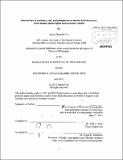Interactions of cadmium, zinc, and phosphorus in marine Synechococcus : field uptake, physiological and proteomic studies
Author(s)
Cox, Alysia Danielle
DownloadFull printable version (27.36Mb)
Other Contributors
Woods Hole Oceanographic Institution.
Advisor
Mak A. Saito.
Terms of use
Metadata
Show full item recordAbstract
A combination of uptake field studies on natural phytoplankton assemblages and laboratory proteomic and physiological experiments on cyanobacterial isolates were conducted investigating the interactions of cadmium (Cd), zinc (Zn), and phosphorus (P) in marine Synechococcus. Enriched stable isotope field uptake studies of ¹¹⁰CD in the Costa Rica Upwelling dome, a Synechococcus feature, showed that uptake of Cd occurs in waters shallower than 40 m, correlates positively with chlorophyll a concentrations and is roughly equivalent to the calculated upwelling flux of cadmium inside the dome. In laboratory experiments, Synechococcus WH5701 cells exposed to low picomolar quantities of free Cd under Zn deficiency show similar growth rates to no added Cd treatments during exponential growth phase, but show differences in relative abundances of many proteins involved in carbon and sulfur metabolism suggesting a great metabolic impact. During stationary phase, chronic Cd exposure in this coastal isolate causes an increase in relative chlorophyll a fluorescence and faster mortality rates. The interactions of acute Cd exposure at low picomolar levels with Zn and phosphate (PO4³-) were investigated in Synechococcus WH8102, an open ocean isolate. The presence of Zn appears vital to the response of the organism to different PO4 ³- cocentrations. Comparisons with literature transcriptome analyses of PO4 ³- stress show similar increases in relative abundance of PO4 ³- stress response proteins including a PO4 ³- binding protein and a Zn-requiring alkaline phosphatase. A bacterial metallothionein, a Zn-associated protein, appears to be correlated with proteins present under low PO4 conditions. Together, these experiments suggest that the interactions of Cd and Zn can affect Synechococcus and play a role in the acquisition of PO4 ³-.
Description
Thesis (Ph. D.)--Joint Program in Chemical Oceanography (Massachusetts Institute of Technology, Dept. of Earth, Atmospheric, and Planetary Sciences; and the Woods Hole Oceanographic Institution), 2011. Cataloged from PDF version of thesis. Includes bibliographical references.
Date issued
2011Department
Joint Program in Chemical Oceanography; Woods Hole Oceanographic Institution; Massachusetts Institute of Technology. Department of Earth, Atmospheric, and Planetary SciencesPublisher
Massachusetts Institute of Technology
Keywords
Joint Program in Chemical Oceanography., Earth, Atmospheric, and Planetary Sciences., Woods Hole Oceanographic Institution.